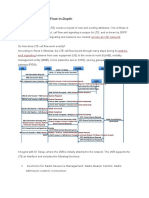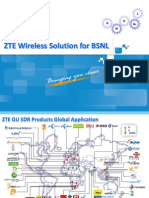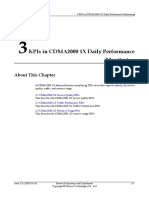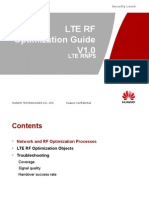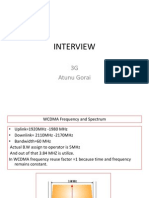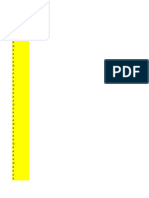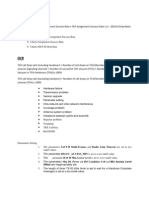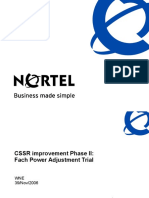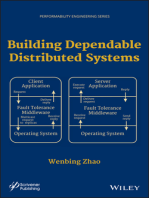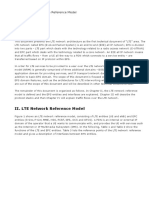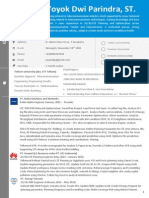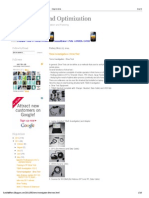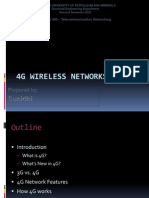3G Interview Q
Uploaded by
Amit Ranjan3G Interview Q
Uploaded by
Amit Ranjan3G interview Q&A
srikanthjadav87
Download
Share Add to Flag Embed
Views: 8133
Category: Education
License: All Rights Reserved
Presentation Description
3G interview Q&A
Comments
Presentation Transcript
Interview Questions 3G UMTS :
Interview Questions 3G UMTS May 2008
Objective:
Objective The main purpose of this is to familiarize ourselves with 3G network and
preparation for interview.
3G Interview Questions:
3G Interview Questions What is WCDMA? KPI for voice and data Pilot Pollution Active set
Handovers Power Control HO Events Noise Rise Loading Factor Factors that affect Capacity
What is Timeslot? What is spreading Factor? What is call chipping? Channels in 3G
HSDPA? HSUPA? FDD? TDD? Spreading Code? Difference between WCDMA and GSM?
Services supported before or with 3GPP ? Theoretical throughput with 3GPP ? How to
calculate capacity per subscriber? 3G Architecture? 3G call flow (MOC)?
3G Interview Answers What is WCDMA?:
3G Interview Answers What is WCDMA? Wideband CDMA , Generation Standard 3GPP.
The access scheme is Direct Sequence Code Division Multiple Access (DS-CDMA) with
information spread over approximately 5MHZ bandwidth. Users signal cover the whole
frequency band all the time. BTS separates the user by applying Spread Spectrum
Techniques. What is Spreading Code? This is Spread spectrum technology. In this each user
is assigned a unique code sequence, the so called spreading code. Spreading code is used to
encode the information bearing signal. The receiver decodes the received signal after
reception with the same code and recovers the original data. The rate of spreading code (
Chip Rate ) is considerably higher than that of the information to be sent ( Bit Rate ),
resulting in a transmission of much higher bandwidth as the unspreaded signal. Why to
Spread? One reason is given in information theory: when information are transmitted at a
given rate, it is possible to have a trade off between bandwidth and signal to Noise ratio (
S/N) respectively. The wider the bandwidth used for transmission at a given information rate,
the lower the S/N ratio is required. Spreaded information shows larger tolerance to
interference of other users, other systems or other technical or natural interference sources (
anti jamming effects).
3G Interview Answers What is WCDMA?:
3G Interview Answers What is WCDMA? Spreading factor? The ratio between the chip rate
and the information rate is denominated as spreading Factor ( SF ) The spreading code or
spreading sequence is independent of the transmitted information. Correlated with the
spreading of the information is a higher bandwidth. The bandwidth after spreading is roughly
SF times the unspreaded bandwidth. For DS-CDMA spreading factors between 10 and 100,
typically some 100 are used. In this way the narrow band signal is spread up for a factor of
some 100 creating a wide band signal. In CDMA as spread spectrum technology the
information are spread by unique digital codes ( Spreading Sequence). The primary
information is spreaded with Chip sequence of a much higher rate ( Chip Rate) as the
primary information rate. Narrow band is multiplied by a very large bandwidth signal.
3G Interview Answers UTRAN KPI Overview:
3G Interview Answers UTRAN KPI Overview Call Setup Success Rate Call Drop Rate of
Signaling Plane Call Drop Rate of User Plane Signaling Congestion Rate Traffic Congestion
Rate Soft Handover Success Rate Hard Handover Success Rate Inter-RAT Hard Handover
Success Rate
3G Interview Answers What is WCDMA?:
3G Interview Answers What is WCDMA? Formula of Call Setup Success Rate: Call Setup
Success Rate = RRCSetupSuccRate RABSetupSuccRate 100% Can be divided into two
parts: CS&PS
RRC Setup Success Rate:
RRC Setup Success Rate The formula of RRC Setup Success Rate: RRC Setup Success Rate
= RRC Connection Setup Success / RRC Connection Request 100% RRC Setup Reject
Causes: Congestion (Walsh, Power, CE, etc.) Unspecified (mostly transmission or NodeB
problem) Other RRC Setup failure reason UE cant receive RRC CONNECTION SETUP
NodeB cant receive RRC CONNECTION SETUP COMPLETE
RRC Connection Setup:
RRC Connection Setup
Example:
Example RRC_REQ 3332 RRC_REJ 2 RRC_REJ_CONG 0 RRC_SETUP 3330
RRC_SETUP_SUCC 3184 RRC_SETUP_SUCC_RATE 95.56% UE cant receive RRC
CONNECTION SETUP The downlink channel transmit power is not enough or the UE
receive sensitivity is not good. NodeB cant receive RRC CONNECTION SETUP
COMPLETE The UE transmit power is not enough or the NodeB receive sensitivity is not
good.
RAB Setup Success Rate:
RAB Setup Success Rate The formula of RAB Setup Success Rate: RAB Setup Success Rate
= RAB Assignment Success / RAB Assignment Request 100% Can be divided into two
parts, for four types of QoS RAB Setup Failure Causes: Parameter violation Non supported
UTRAN capabilities Relocation triggered Transport connection failed to establish
Unavailable resources Protocol error
RAB Setup Flow Chart :
RAB Setup Flow Chart
Example:
Example RB_SETUP 1057 RB_SETUP_SUCC 1054 CS_RAB_REQ_SETUP_CONV 982
CS_RAB_SETUP_SUCC_CONV 979 PS_RAB_REQ_SETUP_BKG 75
PS_RAB_SETUP_SUCC_BKG 75 CS_RAB_SETUP_SUCC_RATE_CONV 99.69%
PS_RAB_REL_SUCC_RATE_BKG 100.00% RB_SETUP_SUCC_RATE_CONV 99.72%
Call Drop Rate of Signaling Plane:
Call Drop Rate of Signaling Plane Call Drop Rate of Signaling Plane is calculated by
counting RNC-originated Iu connection release. Can be divided into two parts: CS&PS RNC-
originated Iu connection release Causes: OM intervention User inactivity Repeated integrity
checking failure UE generated signaling connection release RL out-of-synchronization
Call Drop Rate of Signaling Plane:
Call Drop Rate of Signaling Plane The formula of Call Drop Rate of CS Signaling Plane: Call
Drop Rate of CS Signaling Plane = RNC-originated CS Domain Iu Connection Release /
RNC-originated CS Domain Iu Connection Setup Success 100% The formula of Call Drop
Rate of PS Signaling Plane: Call Drop Rate of PS Signaling Plane = RNC-originated PS
Domain Iu Connection Release / RNC-originated PS Domain Iu Connection Setup Success
100%
RNC-originated Iu connection release Flow Chart:
RNC-originated Iu connection release Flow Chart
Example:
Example RNC_CS_IU_REL 50 RNC_PS_IU_REL 51 RNC_CS_IU_REL_DUP_INTEG 0
RNC_PS_IU_REL_DUP_INTEG 0 RNC_CS_IU_REL_OM 0 RNC_PS_IU_REL_OM 0
RNC_CS_IU_REL_RL_FAIL 26 RNC_PS_IU_REL_RL_FAIL 18
RNC_CS_IU_REL_SIG_REL 5 RNC_PS_IU_REL_SIG_REL 22
RNC_CS_IU_REL_UE_INACT 0 RNC_PS_IU_REL_UE_INACT 0 RNC_CS_IU_SETUP
3085 RNC_PS_IU_SETUP 251 Call Drop Rate of CS Signaling 1.62% Call Drop Rate of PS
Signaling 20.32% For Call Drop Rate of PS Signaling, the main reason is wrong APN
configuration in UE For RL_FAIL, need optimize poor coverage and neighbors, 3G-2G
handover also can improve this indicator
Call Drop Rate of User Plane:
Call Drop Rate of User Plane Call Drop Rate of User Plane is calculated by counting RNC-
originated RAB releases. Can be divided into two parts, for four types of QoS RNC-
originated RAB release Causes: OM intervention UTRAN generated reason RAB preempted
Call Drop Rate of User Plane:
Call Drop Rate of User Plane The formula of Call Drop Rate of CS User Plane: Call Drop
Rate of CS User Plane = RNC-originated CS Domain RAB Release / RNC-originated CS
Domain RAB Setup Success 100% The formula of Call Drop Rate of PS User Plane: Call
Drop Rate of PS User Plane = RNC-originated PS Domain RAB Release / RNC-originated
PS Domain RAB Setup Success 100%
RNC-originated RAB release Cause:
RNC-originated RAB release Cause
Example:
Example CS_RAB_SETUP_SUCC_CONV 979 PS_RAB_SETUP_SUCC_BKG 75
RNC_CS_RAB_REL_REQ_CONV 4 RNC_PS_RAB_REL_REQ_BKG 4 Call Drop Rate of
CS User Plane 0.41% Call Drop Rate of PS User Plane 5.33% For CS/PS_RAB_REL, need
optimize poor coverage and neighbors, 3G-2G handover also can improve this indicator
Soft (Softer) Handover Success Rate:
Soft (Softer) Handover Success Rate The formula of Soft (Softer) Handover Success Rate:
Soft (Softer) Handover Success Rate = Soft (Softer) Handover Success / Soft (Softer)
Handover Request 100%
Soft (Softer) Handover Flow Chart:
Soft (Softer) Handover Flow Chart
SHO Failure Causes:
SHO Failure Causes When the UE handles the ACTIVE SET UPDATE message, the
abnormal cases may be occurred and the UE shall transmit an ACTIVE SET UPDATE
FAILURE message with the following failure causes Configuration unsupported
Incompatible simultaneous reconfiguration Protocol error Invalid configuration If the time
expired before RNC receives the message ACTIVE SET UPDATE COMPLETE or ACTIVE
SET UPDATE FAILURE from UE, RNC increases the SHO failure counter with the
following cause No response from UE
SHO Failure Flow Chart:
SHO Failure Flow Chart
Example:
Example SHO_EVAL_REQ 5652 SHO 5511 SHO_SUCC 5500 SOFTERHO 1411
SOFTERHO_SUCC 1411 SHO_SUCC_RATE 99.8%
Hard Handover Success Rate:
Hard Handover Success Rate The formula of Hard Handover Success Rate: Hard Handover
Success Rate = Hard Handover Success / Hard Handover request 100%
Hard Handover Flow Chart:
Hard Handover Flow Chart
Hard Handover Failure Cause:
Hard Handover Failure Cause The detail hard handover failure cause statistics include two
hard handover directions on the cell object : outgoing hard handover initiated by RNC in each
original cell. incoming hard handover in the target cell initiated by RNC When the UE
handles the PHYSICAL CHANNEL RECONFIGURATION message, the abnormal cases
may be occurred and the UE shall transmit an PHYSICAL CHANNEL
RECONFIGURATION FAILURE message with the following failure cause: Configuration
unsupported Physical channel failure Incompatible simultaneous reconfiguration Protocol
error Cell update occurred Invalid configuration If the time expired before RNC receives the
message PHYSICAL CHANNEL RECONFIGURATION COMPLETE or PHYSICAL
CHANNEL RECONFIGURATION FAILURE from UE, RNC increases the hard handover
failure counter with the following cause No response received from UE
Hard Handover Failure Flow Chart:
Hard Handover Failure Flow Chart
InterRAT Handover to GSM Success Rate:
InterRAT Handover to GSM Success Rate The formula of InterRAT Handover to GSM
Success Rate: InterRAT Handover to GSM Success Rate = inter-RAT handover from
UTRAN to GSM success / inter-RAT handover from UTRAN to GSM attempts 100%
InterRAT Handover to GSM Flow Chart:
InterRAT Handover to GSM Flow Chart
InterRAT Handover to GSM Failure Cause:
InterRAT Handover to GSM Failure Cause When the UE handles the the HANDOVER
FROM UTRAN COMMAND message, the abnormal cases may be occurred and the UE
shall transmit an HANDOVER FROM UTRAN FAILURE message with the following
failure causes Configuration unacceptable Physical channel failure Protocol error Inter-
RAT protocol error Unspecified If the time expired before RNC receives the message IU
RELEASE COMMAND from MSC, RNC increases the InterRAT handover to GSM failure
counter with the following cause InterRAT handover to GSM no response
InterRAT Handover to GSM Failure Flow Chart:
InterRAT Handover to GSM Failure Flow Chart
Example:
Example CS_INTRAT_HO_OUT_PREP 60 CS_INTRAT_HO_OUT_PREP_SUCC 54
CS_INTRAT_HO_OUT_ATT 54 CS_INTRAT_HO_OUT_SUCC 48
CS_INTRAT_HO_OUT_SUCC_RATE(%) 88.89%
CS_INTRAT_HO_OUT_FAIL_CFG_UNSUPP 0
CS_INTRAT_HO_OUT_FAIL_INTER_RAT_PROTCL 0
CS_INTRAT_HO_OUT_FAIL_NO_RSP 0 CS_INTRAT_HO_OUT_FAIL_PHYCH_FAIL
6 CS_INTRAT_HO_OUT_FAIL_PROTCL 0
CS_INTRAT_HO_OUT_FAIL_RELOC_ABORT 0
CS_INTRAT_HO_OUT_FAIL_UNSPEC 0 Need optimize 3G-2G neighbors and
configuration (RNC&CN), 3G-2G handover parameters for example: Report interval/Inter-
RAT handover trigger time/GSM RSSI threshold/ Hysteresis
InterRAT Handover to GPRS Success Rate:
InterRAT Handover to GPRS Success Rate The formula of InterRAT Handover to GPRS
Success Rate: InterRAT Handover to GPRS Success Rate = interRAT handover from
UTRAN to GPRS success initiated by UTRAN / interRAT handover from UTRAN to GPRS
attempts initiated by UTRAN 100%
InterRAT Handover to GPRS Flow Chart - initiated by UTRAN:
InterRAT Handover to GPRS Flow Chart - initiated by UTRAN
InterRAT Handover to GPRS Failure Cause:
InterRAT Handover to GPRS Failure Cause When the UE handles the the CELL CHANGE
ORDER FROM UTRAN message, the abnormal cases may be occurred and the UE shall
transmit an CELL CHANGE ORDER FROM UTRAN FAILURE message with the
following failure causes Configuration unacceptable Physical channel failure Protocol
error Unspecified If the time expired before RNC receives the message SRNS CONTEXT
REQUEST or IU RELEASE COMMAND from SGSN, RNC increases the InterRAT
handover to GPRS failure counter with the following cause InterRAT handover to GPRS
no response
InterRAT Handover to GPRS Failure Flow Chart:
InterRAT Handover to GPRS Failure Flow Chart
3G Interview Answers What is Handover Control?:
3G Interview Answers What is Handover Control?
3G Interview Answers What is Handover Control?:
3G Interview Answers What is Handover Control? The UE sends a CHANNEL REQUEST
message to the network over the random access channel. The network responds with an
IMMEDIATE ASSIGNMENT message so that the UE can occupy the specified dedicated
channel. The UE sends a CM SERVICE REQUEST message to the CN. The network
initiates the authentication and ciphering procedures. After sending the SECURITY MODE
COMPLETE message, the UE sends the SETUP message to the CN to initiate the call setup
procedure. The CN responds with a CALL PROCEEDING message. In the case of
immediate assignment, a communication channel must be assigned to the UE before the CN
initiates the call setup procedure to the fixed network. When the called party rings, the
network must send an ALERTING message to the calling UE upon receipt of the
ALERTING message from the called party. Meanwhile, it also needs to send a ringback tone
to the calling party. When the called party answers, it will send a CONNECT message to the
network and the network will forward this message to the calling party. When the calling UE
returns a CONNECT ACKNOWLEDGE message, the call setup procedure is complete.
3G Interview Answers What is Power Control?:
3G Interview Answers What is Power Control?
3G Interview Answers Difference b/w WCDMA and GSM?:
3G Interview Answers Difference b/w WCDMA and GSM ?
3G Interview Answers Services supported before or with 3GPP ? :
3G Interview Answers Services supported before or with 3GPP ?
3G Interview Answers How to calculate capacity per subscriber? :
3G Interview Answers How to calculate capacity per subscriber?
3G Interview Answers Pilot Pollution? :
3G Interview Answers Pilot Pollution? No. of Pilots (UARFCN = 10563) No. of Samples
Percentage Pilot Pollution % 1 SC 11416 59.8 2 SCs 5449 28.6 3 SCs 1585 8.3 4 SCs 478 2.5
2.5 5 SCs 122 0.6 0.6 6 SCs 26 0.1 0.1 7 SCs 5 0.0 0.0 8 SCs 3 0.0 0.0 9 SCs 0 0.0 0.0 10
SCs 0 0.0 0.0 Total SCs 19084 100.0 3.2 Pilot pollution is the degradation in Ec/Io of the best
serving pilot due to the presence of other pilot signals, which are received at a high level but
do not contribute constructively to the received signal. At each measurement point, the
number of detected CPICHs that fulfil the condition Ec/Io nth cell SC >= Ec/Io Best serving
cell SC 5 dB AND RSCP nth cell SC >=-107 dB has been computed, and statistics have
been calculated. A breakdown of measurement samples according to the number of pilots
(SCs) present is given in table below. Pilot Pollution, Distribution of Strong Pilot Count
(selected cells only)
You might also like
- Mobile Network Optimization: A Guide for 2G and 3G Mobile Network OptimizationFrom EverandMobile Network Optimization: A Guide for 2G and 3G Mobile Network Optimization3.5/5 (3)
- Simulation of Digital Communication Systems Using MatlabFrom EverandSimulation of Digital Communication Systems Using Matlab3.5/5 (22)
- UMTS Access and Retainability Performance Improvement Solution 01 (20120709)No ratings yetUMTS Access and Retainability Performance Improvement Solution 01 (20120709)14 pages
- Bharti Quality Workshop-3G - KPI-KolkataNo ratings yetBharti Quality Workshop-3G - KPI-Kolkata32 pages
- 01-03 KPIs in CDMA2000 1X Daily Performance Monitoring0% (1)01-03 KPIs in CDMA2000 1X Daily Performance Monitoring13 pages
- Huawei UMTS RAN KPI & Counter Introduce (RAN10.0) Nicole V1No ratings yetHuawei UMTS RAN KPI & Counter Introduce (RAN10.0) Nicole V141 pages
- 3G Importants Knowledge For Interview CrackNo ratings yet3G Importants Knowledge For Interview Crack51 pages
- AMDOCS - Optimization Guidelines For Accessibility v1No ratings yetAMDOCS - Optimization Guidelines For Accessibility v122 pages
- 06wk48 - CSSR Improvement Fach Power Trial Phase II - VDF UKNo ratings yet06wk48 - CSSR Improvement Fach Power Trial Phase II - VDF UK19 pages
- 10 FDD LTE Key Performance Indicators Description Guide PDFNo ratings yet10 FDD LTE Key Performance Indicators Description Guide PDF48 pages
- UMTS Performance Trouble Shooting and Optimization Guidelines Ericsson Accessibility100% (1)UMTS Performance Trouble Shooting and Optimization Guidelines Ericsson Accessibility52 pages
- On Which Physical Channel Are The Sibs (System Information Blocks) Transmitted?No ratings yetOn Which Physical Channel Are The Sibs (System Information Blocks) Transmitted?14 pages
- WAN TECHNOLOGY FRAME-RELAY: An Expert's Handbook of Navigating Frame Relay NetworksFrom EverandWAN TECHNOLOGY FRAME-RELAY: An Expert's Handbook of Navigating Frame Relay NetworksNo ratings yet
- Digital Signal Processing Techniques and Applications in Radar Image ProcessingFrom EverandDigital Signal Processing Techniques and Applications in Radar Image ProcessingNo ratings yet
- RF Analog Impairments Modeling for Communication Systems Simulation: Application to OFDM-based TransceiversFrom EverandRF Analog Impairments Modeling for Communication Systems Simulation: Application to OFDM-based TransceiversNo ratings yet
- Data Science and Interdisciplinary Research: Recent Trends and ApplicationsFrom EverandData Science and Interdisciplinary Research: Recent Trends and ApplicationsNo ratings yet
- BICSI RCDD Registered Communications Distribution Designer Exam Prep And Dumps RCDD-001 Exam Guidebook Updated QuestionsFrom EverandBICSI RCDD Registered Communications Distribution Designer Exam Prep And Dumps RCDD-001 Exam Guidebook Updated QuestionsNo ratings yet
- Oversimplified Ham Exam for Technician Class License (2022-2026)From EverandOversimplified Ham Exam for Technician Class License (2022-2026)No ratings yet
- 5G System Design: Architectural and Functional Considerations and Long Term ResearchFrom Everand5G System Design: Architectural and Functional Considerations and Long Term ResearchNo ratings yet
- From GSM to LTE-Advanced Pro and 5G: An Introduction to Mobile Networks and Mobile BroadbandFrom EverandFrom GSM to LTE-Advanced Pro and 5G: An Introduction to Mobile Networks and Mobile BroadbandNo ratings yet
- ZTE SDR BTS - Node B Different Base Station FamilyNo ratings yetZTE SDR BTS - Node B Different Base Station Family39 pages
- Action Plan Down BTS More Than 7 Days 18-05-2020No ratings yetAction Plan Down BTS More Than 7 Days 18-05-20204 pages
- FDD LTE Key Performance Indicators Description GuideNo ratings yetFDD LTE Key Performance Indicators Description Guide48 pages
- ZTE UMTS Services and Radio Access Bearers Feature Guide - V1.1050% (2)ZTE UMTS Services and Radio Access Bearers Feature Guide - V1.1066 pages
- RF Network Planning and Optimization Service UMTS Performance Analysis For Multi-Carrier Capacity Expansion 01-En100% (2)RF Network Planning and Optimization Service UMTS Performance Analysis For Multi-Carrier Capacity Expansion 01-En20 pages
- Mobile Network Optimization: A Guide for 2G and 3G Mobile Network OptimizationFrom EverandMobile Network Optimization: A Guide for 2G and 3G Mobile Network Optimization
- Indoor Radio Planning: A Practical Guide for 2G, 3G and 4GFrom EverandIndoor Radio Planning: A Practical Guide for 2G, 3G and 4G
- Simulation of Digital Communication Systems Using MatlabFrom EverandSimulation of Digital Communication Systems Using Matlab
- UMTS Access and Retainability Performance Improvement Solution 01 (20120709)UMTS Access and Retainability Performance Improvement Solution 01 (20120709)
- 01-03 KPIs in CDMA2000 1X Daily Performance Monitoring01-03 KPIs in CDMA2000 1X Daily Performance Monitoring
- Huawei UMTS RAN KPI & Counter Introduce (RAN10.0) Nicole V1Huawei UMTS RAN KPI & Counter Introduce (RAN10.0) Nicole V1
- AMDOCS - Optimization Guidelines For Accessibility v1AMDOCS - Optimization Guidelines For Accessibility v1
- 06wk48 - CSSR Improvement Fach Power Trial Phase II - VDF UK06wk48 - CSSR Improvement Fach Power Trial Phase II - VDF UK
- 10 FDD LTE Key Performance Indicators Description Guide PDF10 FDD LTE Key Performance Indicators Description Guide PDF
- UMTS Performance Trouble Shooting and Optimization Guidelines Ericsson AccessibilityUMTS Performance Trouble Shooting and Optimization Guidelines Ericsson Accessibility
- On Which Physical Channel Are The Sibs (System Information Blocks) Transmitted?On Which Physical Channel Are The Sibs (System Information Blocks) Transmitted?
- WAN TECHNOLOGY FRAME-RELAY: An Expert's Handbook of Navigating Frame Relay NetworksFrom EverandWAN TECHNOLOGY FRAME-RELAY: An Expert's Handbook of Navigating Frame Relay Networks
- CCNA Exam Focus: Study Guide with Practice TestsFrom EverandCCNA Exam Focus: Study Guide with Practice Tests
- Digital Signal Processing Techniques and Applications in Radar Image ProcessingFrom EverandDigital Signal Processing Techniques and Applications in Radar Image Processing
- Intelligent Technologies for Automated Electronic SystemsFrom EverandIntelligent Technologies for Automated Electronic Systems
- LTE Signaling: Troubleshooting and Performance MeasurementFrom EverandLTE Signaling: Troubleshooting and Performance Measurement
- RF Analog Impairments Modeling for Communication Systems Simulation: Application to OFDM-based TransceiversFrom EverandRF Analog Impairments Modeling for Communication Systems Simulation: Application to OFDM-based Transceivers
- Data Science and Interdisciplinary Research: Recent Trends and ApplicationsFrom EverandData Science and Interdisciplinary Research: Recent Trends and Applications
- CCNA Exam Excellence: Study Guide & Practice TestsFrom EverandCCNA Exam Excellence: Study Guide & Practice Tests
- 6G Wireless Communications and Mobile NetworkingFrom Everand6G Wireless Communications and Mobile Networking
- BICSI RCDD Registered Communications Distribution Designer Exam Prep And Dumps RCDD-001 Exam Guidebook Updated QuestionsFrom EverandBICSI RCDD Registered Communications Distribution Designer Exam Prep And Dumps RCDD-001 Exam Guidebook Updated Questions
- CCNA Interview Questions You'll Most Likely Be AskedFrom EverandCCNA Interview Questions You'll Most Likely Be Asked
- Oversimplified Ham Exam for Technician Class License (2022-2026)From EverandOversimplified Ham Exam for Technician Class License (2022-2026)
- 5G System Design: Architectural and Functional Considerations and Long Term ResearchFrom Everand5G System Design: Architectural and Functional Considerations and Long Term Research
- From GSM to LTE-Advanced Pro and 5G: An Introduction to Mobile Networks and Mobile BroadbandFrom EverandFrom GSM to LTE-Advanced Pro and 5G: An Introduction to Mobile Networks and Mobile Broadband
- ZTE SDR BTS - Node B Different Base Station FamilyZTE SDR BTS - Node B Different Base Station Family
- FDD LTE Key Performance Indicators Description GuideFDD LTE Key Performance Indicators Description Guide
- ZTE UMTS Services and Radio Access Bearers Feature Guide - V1.10ZTE UMTS Services and Radio Access Bearers Feature Guide - V1.10
- RF Network Planning and Optimization Service UMTS Performance Analysis For Multi-Carrier Capacity Expansion 01-EnRF Network Planning and Optimization Service UMTS Performance Analysis For Multi-Carrier Capacity Expansion 01-En






